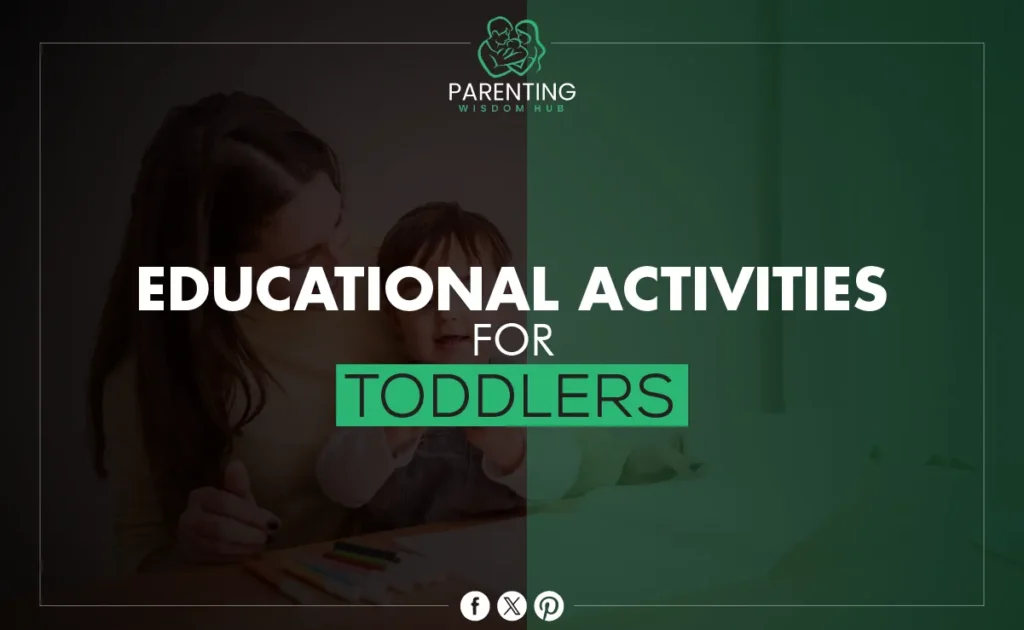Introduction
Early childhood shapes a child’s learning, behavior, and health. Educational activities, especially play-based ones, are vital at this stage. Toddlers learn about the world and acquire lifelong skills via mindfully structured play.
Educational activities for toddlers keep them engaged and improve their development. We teach kids thinking, learning, and problem-solving by giving them structured tasks that engage their senses and thoughts.
Read more about Educational Activities for prescholers.
Understanding Toddlers’ Developmental Needs
To choose the right educational tasks for toddlers between the ages of 1 and 3 years, it’s essential to know what developmental milestones they are reaching. Several areas of development change quickly during these years, and each milestone is an integral part of their total growth.
Developmental Milestones for Toddlers (Ages 1-3)
At this age, toddlers almost always start to:
- They learn to walk and then run, which makes them more agile and improves their balance.
- Say their first few words and then move on to making short sentences.
- Names and things must be recognized, which are basic cognitive skills.
- They are becoming more independent by feeding themselves and picking out their toys to play with.
- Learn basic social skills by doing things like playing with other kids and starting to play simple, engaging games.
Cognitive, Social, and Physical Capabilities
Toddlers are like little explorers at this age; they learn primarily by making mistakes:
- Cognitive: They start to understand how one thing can cause another to happen. They can also fix problems by trying different things and following simple one—or two-step directions.
- Social: Socialization becomes deliberate. Toddlers learn to share and collaborate, even if they don’t always comply. They develop empathy and recognize others’ emotions and facial expressions.
- Physical: There are clear improvements in both fine and gross motor skills. Fine motor skills include using tools, turning pages, and stacking blocks, while gross motor skills include climbing, jumping, and running.
The Role of Play in Learning and Growth
Children under two years old play constantly; it’s how they learn most. Toddlers learn through play:
- Try new things and learn about their surroundings, essential for brain growth.
- Communicating your needs, wants, and thoughts is an excellent way to improve your language skills.
- Improve their health by doing different tasks that use their bodies and improve their motor skills.
- Spend time with adults and other kids in various settings to improve your social skills.
Play is naturally educational and the best way for children to learn. Knowing about these developmental needs and milestones allows caregivers to choose activities that help toddlers grow in all areas.
Sensory Play Activities
These activities help toddlers develop their senses—touch, smell, taste, movement, balance, sight, and hearing—and improve cognitive development, fine and gross motor skills, problem-solving, and socialization. Sensory play also helps children learn more complicated activities by building nerve connections in the brain’s circuits.
Benefits of Sensory Play for Toddlers
- Enhances Memory: Sense events are linked to remembering things.
- Supports Language Development: Children’s language skills are improved when they talk about their senses.
- Cultivates Fine Motor Skills: Moving small things around helps build muscle in the hands and arms.
- Encourages Problem-Solving: Kids can learn about cause and effect by playing with different things.
- Promotes Calmness: It offers healing benefits, especially for kids who are anxious or angry.
Activity: Homemade Sensory Bins
Materials Needed:
- Something big and shallow
- Bases like sand, rice, pasta, beans, or pasta
- Small toys or things with different textures
- Cups, spoons, or scoops
Instructions:
- Choose Your Base: Use the base material you picked to fill the lid.
- Add Items and Tools: Include a bunch of small toys for the child to find. Also, include scoops and cups so that you can dig and pour.
- Play Guidance: Allow the kid to explore without being told what to do, but help them feel, explain, and play with the things they find.
Activity: Water Play Ideas
Setup:
- A big bowl or a little pool that you can blow up.
- Water that is warm and clean
- Waterproof toys include ducks, cups, and sieves.
Safe and Simple Water Play:
- Fill the Basin: Add just the right amount of water to make it fun and safe.
- Add Toys: Give them toys to help them learn how to pour, scoop, and stir.
- Supervised Play: Always watch the kids while they play in the water to ensure they are safe.
Both homemade sensory bins and water play sets are great ways for children to use all of their senses, learn in a fun way, and develop essential skills in a fun, hands-on way.
Motor Skills Development
Toddlers’ motor skills affect everything from nursing to writing. These skills depend on physical coordination, cognitive development, and independence. Motor skill activities boost toddlers’ confidence and environment interaction.
Importance of Motor Skills in Early Childhood
There are two main types of motor skills:
- Fine Motor Skills: These use fingers, hands, and wrists to make smaller moves. Good fine motor skills are needed to hold a pencil, zip up a jacket, or play with toys.
- Gross Motor Skills: These use more significant moves of the arms, legs, feet, or even the whole body. Gross motor skills help you walk, jump, balance, and be physically quick.
A child’s physical, independence, and mental health rely on them learning these skills.
Activity: Building with Blocks
Benefits:
- Toddlers improve their fine motor skills by building, gripping, and balancing blocks.
- Problem-solving and experimenting are good ways to boost cognitive growth.
- It makes you more creative and aware of your surroundings.
Creative Ways to Engage:
- Color Sorting: Help babies learn to recognize colors by having them build towers out of blocks of the same color.
- Counting Games: Toddlers can learn to count while playing with blocks by being told to stack a certain amount.
- Storytelling with Structures: Help children build a house, zoo, or city and then use it as a stage for a story.
Activity: Simple Puzzles
How They Help in Problem-Solving:
- Toy puzzles help toddlers learn to spot patterns, shapes, and colors by giving them something to think about.
- Toddlers must match pieces based on either form or picture, which helps their hand-eye coordination and fine motor skills.
- Figuring out puzzles makes you feel good about yourself and gives you a sense of success, which is good for your emotional and mental growth.
Block building and basic puzzles are fun and educational activities that help toddlers improve motor skills. These activities foster physical and cognitive development and lay the groundwork for future learning.
Language and Communication Skills
Toddlers need language and communication skills to interact with the world. They learn complicated linguistic patterns and develop vocabulary through contact with caregivers and peers.
How Toddlers Develop Language Skills through Interaction
Toddler language development depends on interaction. Talking, reading, and singing teach toddlers new words, linguistic patterns, and communication skills. These interactions help learn social signs like taking turns speaking and listening, which are essential for efficient communication.
Activity: Storytime Sessions
Tips for Making It Interactive:
- Use Voice Modulation: Your pitch and tone should change for each character and scene. This keeps the child busy and helps them figure out how others feel.
- Ask Questions: Stop reading and ask the child what they think will happen next or about the characters and things in the book. This makes people more likely to take part.
- Incorporate Gestures: Bring the story to life with hand gestures or facial expressions. This will help the toddler stay interested and understand better.
Benefits:
- It helps you listen better.
- It enables you to understand and think more clearly.
- Boosts your knowledge by exposing you to new words repeatedly.
Activity: Sing-Along Songs and Basic Rhymes
Enhancing Verbal Skills:
- Repetition: Rhymes and songs that repeat words and sentences help you remember them.
- Rhyme and Rhythm: Toddlers can better remember sounds and patterns when they hear songs and rhymes with a beat, making learning language easier.
- Interactive Elements: To make the experience more enjoyable, encourage people to clap, stomp, or make animal sounds.
Benefits:
- It helps you become more aware of phonemes, essential for reading.
- Songs and rhymes often use silly language, which can help children remember and be interested in them.
- It helps with speaking clearly and expressing thoughts.
These tasks make learning a language fun and part of a toddler’s daily life, a great way to improve their communication skills.
Art and Creativity
Young children develop creativity and emotional expression through art. Art helps toddlers healthily express their emotions and imaginations. This can help individuals solve problems and comprehend themselves and the world.
The Impact of Art on Creative and Emotional Development
Artistic activities help infants develop cognitively by encouraging creative thinking and experimenting. Toddlers can also communicate many feelings through art. Creating helps them express feelings they can’t yet express, which is crucial for emotional maturation.
Activity: Finger Painting and Non-toxic Paint Usage
Materials Needed:
- Safe, washable paint
- A lot of paper
- Shirts or smocks to preserve clothes
- An area that is covered or easy to clean
Instructions:
- Prepare the Space: Place the paper flat and use tape to keep it from moving.
- Introduce the Paints: Put different colors on shallow plates or paper.
- Encourage Exploration: Let the little kid draw with their fingers. Show them how to make designs and mix colors.
Benefits:
- Toddlers’ fine motor skills improve when their fingers move paint around.
- The texture and feel of paint help kids grow their senses.
- It helps people show how they feel through color and style choices.
Activity: Easy Crafts Using Household Items
Materials Needed:
- Items like paper plates, toilet paper rolls, and old buttons
- Glue
- Scissors (for adult use only)
- Markers or crayons
Craft Ideas:
- Paper Plate Masks: Toddlers can use markers to paint paper plates and string them together to wear as masks.
- Toilet Roll Binoculars: To make two toilet paper rolls look nice, glue them together and add a string to hang them around your neck.
Benefits:
- Kids can be creative by thinking of new ways to use everyday things.
- Cutting, gluing, and putting things together helps with small motor skills.
- Teaches people about the environment by showing them how to recycle in real life.
Art and craft activities are fun and educational. They support cognitive growth, fine motor abilities, and emotional well-being. These easy but creative activities allow toddlers to express themselves and try new things.
Outdoor and Nature Activities
Toddlers need outdoor play for more than exercise. Sensory stimulation, investigation, and environmental awareness are possible. Nature activities help infants reconnect with nature, improving their health and curiosity.
Benefits of Outdoor Play for Physical Health and Exploration
- Physical Health: Running, jumping, and climbing are great ways to improve cardiovascular health, power, balance, and coordination when you exercise outside.
- Sensory Skills: Outside, toddlers can discover different sounds, textures, and smells suitable for their sensory development.
- Cognitive and Emotional Growth: Nature play makes kids curious and creative, and it’s also a relaxing activity that can help young kids feel less stressed.
Activity: Nature Scavenger Hunts
What to Include in Your List:
- A leaf of a specific shape or color
- A smooth stone
- A feather
- Flowers of different colors
- Pinecones, acorns, or seeds
Instructions:
- Prepare the List: Make a manageable list of things toddlers need to find. Using pictures instead of words will help them find what they want.
- Explore Together: As you walk with your child, tell them to look around and pick up things they see.
- Discuss Finds: As they find things, they talk about their colors and textures and what they can be used for in nature. This will help them learn more.
Benefits:
- It helps you learn to observe and pay attention to details.
- This activity allows you to learn about nature and the world through hands-on activities.
- It enables you to talk to each other better as you speak and discover together.
Activity: Simple Gardening Activities
Growing Easy Plants:
- Sunflowers
- Cherry tomatoes
- Radishes
Materials Needed:
- Seeds of chosen plants
- Small pots or a garden patch
- Soil
- Watering can
Instructions:
- Plant the Seeds: Help your child put soil in pots and plant seeds by following the directions on the seed packet.
- Regular Care: Show your kid how to water the plants and check their daily growth.
- Harvest Together: Harvesting the plants with others can be fun and satisfying once fully grown.
Benefits:
- Educates people on how to be responsible and take care of living things.
- Teaching science and the environment through real-life examples.
- Sees the effects of one’s work and brings joy and satisfaction.
Outdoor and natural activities improve toddlers’ physical health and worldview. These experiences shape young minds and bodies, making them crucial to childhood development.
Incorporating Educational Technology
Technology can be a valuable tool for educational growth in this digital age when used correctly. Introducing toddlers to technology requires choosing the right time, material, and limits to ensure a healthy balance.
When and How to Introduce Toddlers to Technology
When to Introduce:
- Usually, kids should start using technology around the age of two years.
- When first introduced, kids should watch without a parent or caretaker’s supervision. As they age, they should be able to interact with the TV.
How to Introduce:
- Start with supervised sessions to teach basic ways to connect with others.
- Don’t use technology instead of classic games; add it to them.
- Discuss what the child sees and learns as you interact with the material.
Guidelines for Screen Time for Toddlers
- Limit Screen Time: The American Academy of Pediatrics says kids ages 2 to 5 shouldn’t spend more than an hour daily before a good screen.
- Ensure Quality Content: Choose valuable apps for kids without ads that could confuse or distract them.
- Be Present: It’s important to watch TV or movies with your child to help them learn and keep an eye on what they’re watching.
- Encourage Active Participation: To improve brain growth, choose apps that make you think and interact with them rather than ones that just let you watch.
Technology should enhance a toddler’s learning experience rather than replace it. Parents and caregivers may guarantee that early technology use benefits children by picking the correct times and equipment.
Conclusion
Getting toddlers involved in educational activities isn’t just fun; it’s an integral part of their growth and development that will help them in many ways.
Parents and caregivers must frequently include various educational activities in toddlers’ everyday routines. Continuous involvement encourages learning and meets developmental milestones. Regular activities allow Toddlers to explore their strengths and boundaries in a supportive environment.
Beyond developmental benefits, these activities allow toddlers and parents to bond and enjoy themselves. They make precious memories and improve parent-child bonds. These experiences—laughing over a silly song, making crafts, or exploring nature—are priceless.
Daily educational activities for toddlers are an investment in their future. These activities help them succeed academically and develop lifelong social and emotional skills. Take this chance to explore, learn, and grow with your toddler—it will be a memorable experience.


